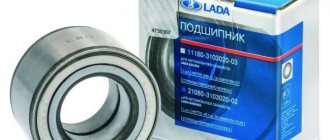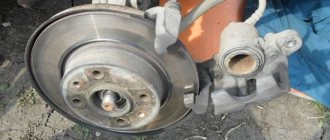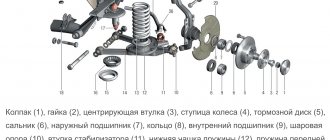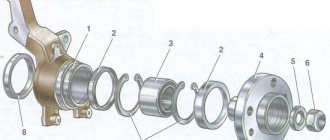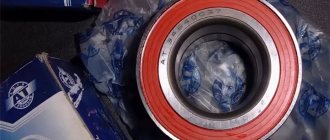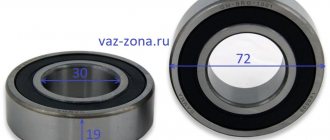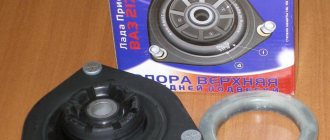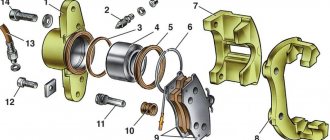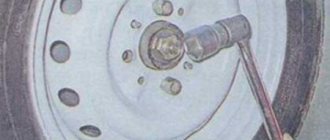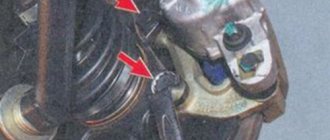Sooner or later, any car owner will be faced with a problem related to the failure of the front wheel bearing on a Grant. It is good if the product is replaced on time, when the first signs are detected. It is worse if the driver ignores signs indicating a faulty element, which can lead to a serious traffic accident.
The main purpose of wheel bearings is to maintain and ensure proper rotation of the wheels. From a structural point of view, the product consists of two metal rings, between which there are rollers or balls, an insulating material that prevents debris from entering and lubricant from leaking out of the product.
Symptoms of a problem
Problems associated with the front hub are identified by the following symptoms:
- extraneous, unnatural noise from the wheel during rotation;
- wheel beating, vibrations of varying degrees of intensity;
- sounds of scraping metal;
- front wheel play appears.
Causes of breakdowns
The service life of the product is quite long and amounts to about one hundred thousand kilometers, subject to gentle operation. However, in real “combat” conditions, the element fails much earlier than its allotted time. Here are 3 important factors that significantly reduce the service life of a bearing:
- Unsatisfactory condition of roads. The fact is that when driving on an uneven surface, wheel bearings take on increased load, sudden impacts, and exposure to high and low temperatures. Over time, the metal components of the product become brittle and begin to break down.
- Aggressive environments. Due to the fact that the element is located in the center of the wheel, it is constantly in contact with moisture, water, dust, and dirt. In winter it is exposed to cold temperatures and in summer to hot temperatures.
- High operating temperatures. The rotation process is accompanied by the natural release of heat; constant heating and cooling occurs (especially in winter conditions), which has a detrimental effect on strength and wear resistance.
The device of the hub on the Lada Grant
Front
- rounded fist;
- external and internal dirt-reflective metal rings;
- front roller bearings;
- hub;
- washer;
- hub nut;
- retaining ring, plug.
Rear hub device
- hub mechanism axis;
- metal ball bearing;
- mud ring;
- retaining ring;
- washer;
- screw;
- sealing ring;
- rubber boot;
- hub cover.
Resource for replacing hub mechanism elements
The average service life of wheel joints is 80 – 85 thousand km. The indicator is average, as it depends on the following factors:
- quality of workmanship of the part;
- frequency of operation of the technical device;
- driving style;
- quality of road surface;
- aggressive environment;
- high operating temperatures;
- compliance with technical inspection intervals.
Signs that a hub needs to be replaced
- the appearance of uncharacteristic noise during wheel rotation;
- wheel runout in the steering column;
- vibrations at different speeds. Sometimes there is vibration at a certain speed;
- metallic grinding noise as the wheel rotates;
- front wheel hub play.
Diagnostics of the hub mechanism
- We place the car on a level platform, squeeze the parking brake if we are checking the front row. For the rear, we install wheel chocks.
- Let's jack up the front (rear) part.
- We turn the car wheel and carry out troubleshooting.
- We shake the wheel up and down with our hands. In good condition there should be no play. Otherwise, we dismantle and replace worn elements.
Replacing the front wheel bearing on a Grant
Work related to removal and installation will require special tools, namely: - a special hub puller; - chisel; - hammer; — a long lever or a specialized wrench to loosen the hub nut; - set of heads; - center punch; — a knob or key set to “30”; - a flat-head screwdriver; — retaining ring remover (or pliers with round ends); - jack or ditch lift; — wheel stands (2 pieces).
Conventionally, all work can be divided into 18 stages:
- Place the vehicle on a level surface, provide acceptable lighting conditions, and place chocks under the rear wheels.
- We loosen, but do not unscrew the bolts securing the wheel where replacement is planned.
- We loosen the tightening torque for the hub nut (it is most convenient to use a long lever).
- Using a jack, we lift the required side of the car. We dismantle the wheel.
- Using a screwdriver, pry and disconnect the protective plastic cap of the hub.
- Using a hammer and a center punch, straighten the shoulder of the bearing nut.
- Unscrew the hub nut. Please note that the tightening torque is quite high, so it is necessary to use a special wrench or tool with a long lever. Remove the nut and washer. Remove the brake disc.
- Disconnect the wheel drive.
- Unscrew the two bolts of the strut and ball joint.
- Unscrew the steering knuckle fasteners and remove it from the CV joint.
- We install the unit in a vice and, using a head of the required diameter, press in the wheel bearing.
- Remove the special protective ring.
- We place the chisel between the ends of the inner ring and, applying small blows with a hammer to the chisel, tear the ring to the side. Using a special puller we dismantle it.
- Using pliers or round-nose pliers, remove the retaining ring and remove the bearing.
- Using a brush with metal bristles, clean the inside of the steering knuckle from dirt. Then apply lubricant to the cleaned surface.
- Install the new product back into the steering knuckle.
- Further assembly is carried out in reverse order.
Now you know how to change the front wheel bearing on a Grant at home, without resorting to the help of car services.
Lada Granta front wheel bearing replacement. Photo and video instructions
We have a Lada Granta car under repair, on which the front wheel bearing will need to be replaced. We will show you detailed photos and video instructions on how to do it yourself correctly and quickly.
We will immediately describe our special tool that will be used in the repair. A reverse hammer for removing the hub; if you don’t have one, you can use a regular hammer and a copper mandrel of suitable size. To press the bearing out of the reverse knuckle you will need the following puller:
This is a powerful bolt, a set of washers, a thrust bearing and a metal cup into which the bearing will be pressed. When removing one of the inner rings of the wheel bearing (when pressed out, one always remains on the hub), you will need the following puller consisting of two half rings:
Let's get to work, remove the wheel, unscrew the hub nut:
Using the E12 head, unscrew the two bolts securing the brake mechanism to the steering knuckle:
It is best to use a large wrench for these purposes; the bolts will wobble over time and become difficult to unscrew. First, clean the heads with a wire brush.
We turn the brake mechanism left and right, recess the piston a little and remove it from the brake disc, then hang it so that it is not in the way and its hose is not under load. We remove the brake disc from the hub, before doing this we unscrew the fixing screws, but we don’t need to do this, since they are broken off.
When removing and installing the hinge, you can easily damage the ABS sensor, so to prevent this from happening, we unscrew it with the E8 head:
Now we remove the hub, we need to press it out of the inner race of the bearing, as we already wrote, this can be done in two ways, using a reverse hammer:
As a connecting link, we use the cylinder head bolts, they have the same thread as the wheel bolts, we completely wrap them into the “body” of the hub so as not to damage the threads.
The second option is to remove the hinge, unscrew the ball joint and hit the hub from the inside through a copper mandrel, if there is no reverse hammer. We removed the hub, but one of the halves of the inner race remains with the hub and we will need to remove it.
Changing the rear wheel bearing of Lada Granta
Replacing the rear wheel bearing of a Lada Granta
Front-wheel drive models of this line require periodic replacement of the rear wheel bearing in the same way as a rear-wheel drive car.
As a rule, their failure is indicated by the appearance of extraneous noise that occurs when the car is moving, grinding and vibration.
Primary diagnostic option
To confirm the version of bearing failure (CCD), you should perform a simple diagnosis:
Place the wheel on a jack; Unscrew it by hand (pay attention to the appearance of noise); If there is a malfunction, rotation is noticeably difficult; There is noticeable wheel play.
To pinpoint the problem, you will need to dismantle the unit and remove the hub.
What bearings need to be purchased for replacement?
If you select from the AVTOVAZ catalog, you will need product 21080-3104020.
When selecting according to the markings introduced by the current GOST, you will need 256706 AKE12.
In addition, the required bearing can be selected from analogues recommended by the manufacturer:
- Russian brand VBF – type 2108-3104020;
- Domestic brand SPZ – type 2108-3104020;
- FAG – type 545312A;
- SKF – type VKBA1307.
This is a double row angular contact ball bearing, made in a closed design.
Algorithm for replacing a faulty CCD
A significant advantage of the design of this vehicle is the ease of replacement work. No special tools, such as a puller or press, are required.
All upcoming work can be divided into three stages: dismantling the faulty product, installing a new bearing, and reassembling the unit.
Removing a faulty CCD:
- Remove the locknut protective cap. Unbend the rolled lock to prevent unauthorized unwinding.
- Loosen the locknut (most likely you will need a wrench or an extended handle).
- Loosen the wheel bolts.
- Hang it on a jack.
- Unscrew the bolts securing the brake drum.
- Unscrew the hub nut. Remove the latter from the axle shaft.
- Remove the retaining ring from it.
- Using a chisel, remove the protective ring.
- Treat the bearing installation area with WD40.
- Remove the faulty bearing.
To do this, you can use a puller, a hammer and a mandrel, a hydraulic press, a vice (one of the options). When replacing yourself, most often, a vice is used.
- We clamp the structure in a vice and press out the CCD.
- To completely remove the bearing, you will need to install stops (since it rests on the jaw).
- The last 5-10 mm are “achieved” with a hammer through a mandrel.
Installing a new bearing
Clean the mounting surfaces and re-lubricate them and the outer race of the new CCD.
- We place the new product in the mounting hole. We bait (using the old one instead of a mandrel) by about 5-10 mm.
- We clamp the assembly in a vice (to control possible distortion).
- Carefully tighten the clamp until the end rests on the existing inner side.
- Install the retaining ring.
Reassembly
To bring the hub to its original position, the following operations must be performed.
- Before pressing the assembly, lubricate the surface of the axle shaft.
- Fit the knot, screw and tighten the hub nut.
- Finishing broaching is done using a torque wrench.
- The hub nut is locked (chisel, hammer). After that, the brake drum is put on, the wheel is screwed on and mounted.
